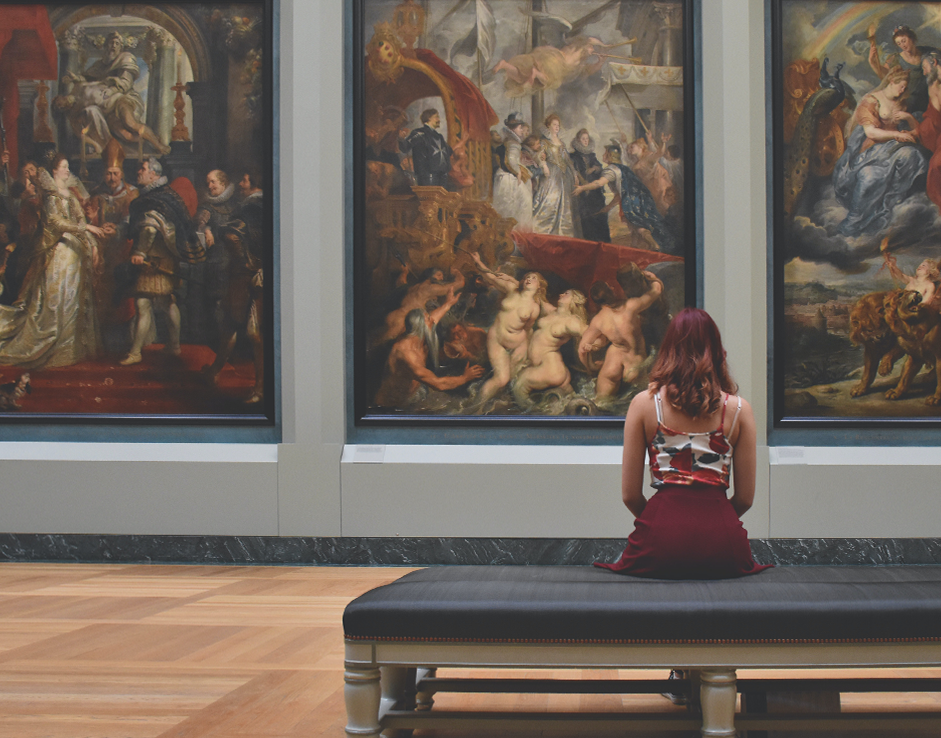18TH CENTURY
Although extravagant men’s wardrobes were prominent in the seventeeth century, those of the eighteents century became more subtle and refined. The seventeeth century menb’s jacket, the justaucorps, was replaced in the second half of the eighteenth century by the habit (coat), which was worn with a waistcoat and knee-breeches.

Man’s Suit (coat, waistcoat, and breeches) English C.1740
Wine, red wool; coat and waistcoat decorated with gold braid and buttons wrapped with gold threads; sleeved waistcoat; jabot of Valencienned lace: sleeve ruffles of Bienche lace.
Right
Man’s Suit (coat, waistcoat, and breeches) French C.1765
Deep-yellow velvet woven with small floral figures and cartouches; buttons wrapped with silver threads; sleeveless waistcoat; jabot and sleeve ruffles of nobbin lace.

C.1760
Pink suit of silk brocade with double leaf motif; wide folded back cuffs; waistcoat with sleeves in different fabrics; jabot and sleeve ruffles of Brussels apliqued lace with floral patterns.

French Mid 18th century
Light-yellow chamois leather; buttons: metal in a checked pattern. This stylish hunting jacket is made of flexible and strong chamois leather. The flaps can either be folded back as reverse or fastened double-breasted.

The fabric with the water blotting pattern was called chine la branche in French. Just as the Japanese hogushi-weaving ( a type of kasuri technique), the pattern was printed onto the warp prior to weaving. In Europe, the chine technique was extremely difficult, so the large chine patterns were produced only in France. The patterns were mainly apllied on thin fabrics such as silk taffeta. Light patel coloring and fluffy texture are charestic of chine.During the mid eighteen century, it was fashinoble to use chie for high priced summer clothing. Since Madame de Pompadour strongly preferred wearing dresses of chine, it was often called “Pompadaur Taffeta”.

Madame de Pompedour,1759
The Wallece Collection, London

French C1765
Light blue Lyons silk chine with cartouche- enclosed floral motif; self-fabric trim; double flounced cuffs; matching stomacher and petticoat; engageantes of Alançon lace; lappets and bommet pf Argentan lace.
Extravagant silk made in Lyons were inseparable from rococo fashion. Silk fabric production in Lyons became technically advanced through the support of the French government. Due to this development, the fabric designs included a wide variety of garland, ribbon and lace patterns, all of which used diverse styles of fine curving lines and decorative elements. Lyons silk became one of the most highly regarded commodities in Europe. Although quilted skirts were often seen in eighteen-century fashion, a dress quilted all over such as below is rare and extremely precious.

1760s-1770s,; fabric 1750s-1760
Blue silk brocade with lace and flower motif self-fabric trim and fly fringe ornamentation; pagoda sleeves; matching petticoat.

English C.1750-1755
Yellow silk satin with geometric and plant-patterned quilting.
The vogue of stripe spread through all the social classes starting in the 1770s. In the Magasin des Modes, a fashion magazine that was published in the 1780s just prior to the French Revolution, both men’s and women’s fashions with vertical stripes of two colors frequently appeared. The trend of the stripe in the fashion continued during the French Revolutionary period.

Dresses ( robes a la française)
French C.1770-1775
Pink Lyons brocade with stripe and floral pattern; self fabric and fly fringe trim; single flounced pagoda sleeves; matching petticoat
Yellow Lyons brocade with white floral stripe; comperes with buttons; double flounced pagoda sleeves; matching petticoat.
Blue Lyons silk cannele with stripe and floral ribbom motif; comperes with butoons; souble flounced pagoda sleeves; matching petticoat.
Functional elements of clothing appeared in mid eighteen century women’s fashion. In this dress, the comperes were connected to the front opening of the robe with either hooks or buttons., so the stomacher was no longer necessary. The comperes are simpler and more practical than the stomacher, which had to be pinned to the dress each time.
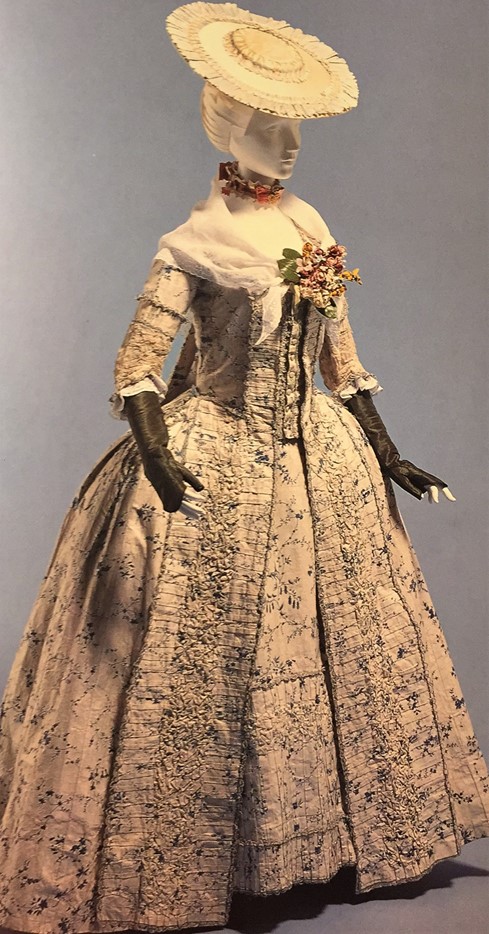
White linen chinez with blue plany motif; comperes with buttons; matching petticoat.
Flounces, fly fringe, artificial flowers, ribbons and chenille are essential ornaments for rococo fashion. This dress is adorned with delicate fly fringe, chenille, and bouilonne filled with cotton to give more of a three-dimensional look. Although the decorations are excessive, they perfectly harmonize with each other, and represent the most sophisticated and delicate sprit of the rococo style.
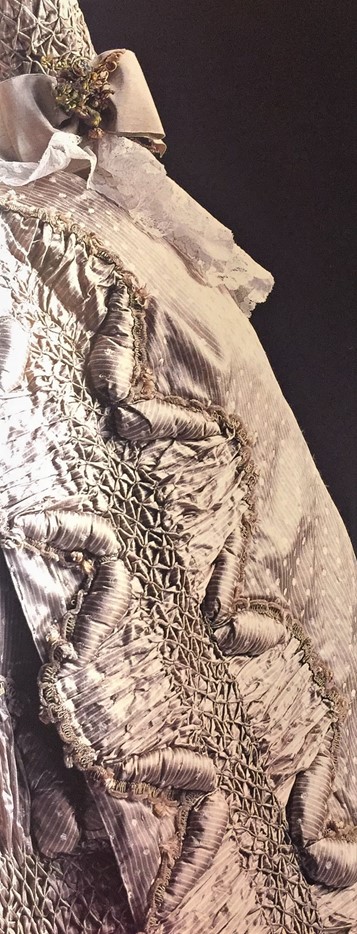
C.1775
Beige silk satin with thin stripe and dot pattern; comperes front; matching petticoat; padded three -dimensional decoration with smocking; fly fringe and chenille at front.
The popularity of Anglomania led everyday costumes to be simple during the last half of theeighteen century. In contrast, women’s court fashion at the time presented an exaggerated with a bodice tightly fitted by corset, and a wide skirt expanded on each side by a pannier. Representing the extreme beauty of artificiality, the widely expanded dress and high coiffures remained as court costume until the Revolution.
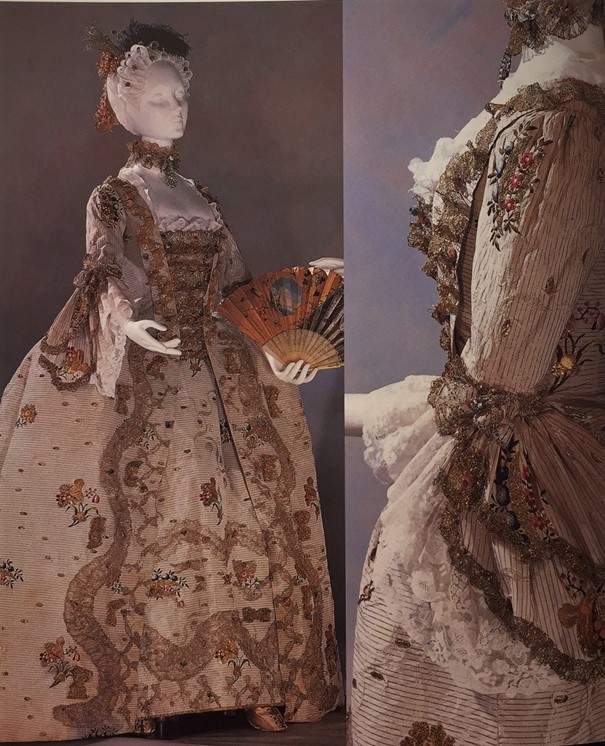
English C.1760
Ivory Spitalfields sil brocade of gold, silver, and polychrome threads with floral pattern, gold lace, silver gauze; double-flounced pagoda sleeves; matching petticoat; stomacher of gold and silver lace and fly fringe; engageantes of Brussels lace.
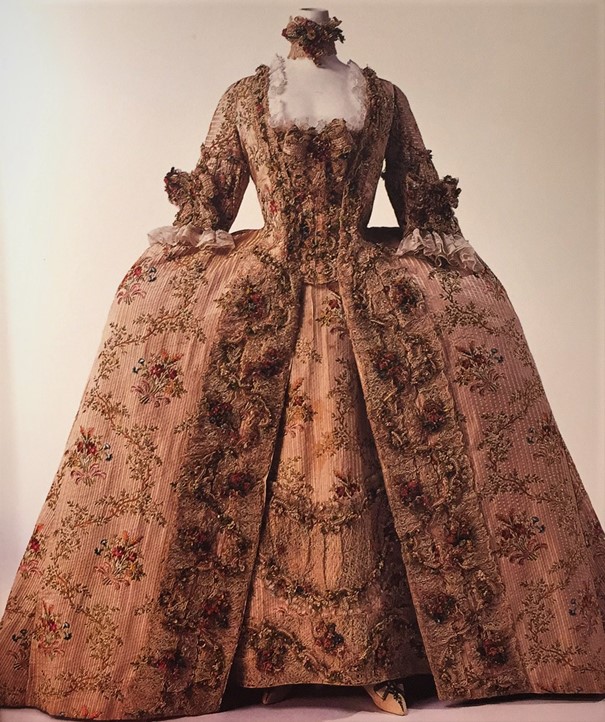
French 1775-1779
Ivory Lyons silk striped brocade with floral patterns of chenille, self fabric trim; matching petticoat; stomacher of matching fabric with flower ornaments of chenille; sabot sleeves.
The typical eighteen century French suit, the habit a la française, consisted of a coat, a waistcoat, and breeches. It also included a pair of silk stockings, a jabot, a linen or cotton shirt with decorative cuffs, and cravat. Men’s suit transformed to a more functional style in the last of the eighteenth century.
Overall the coat became tight fitting, the length of the waistcoat became short, the weistcoat’s were removed, and the hem was cut horizontally. Yet the brilliant colors, exquisite embroideries, elaborate lace for jabots and cuffs, and decorative buttons still remained important elements for dressing a gentleman in the rococo style.
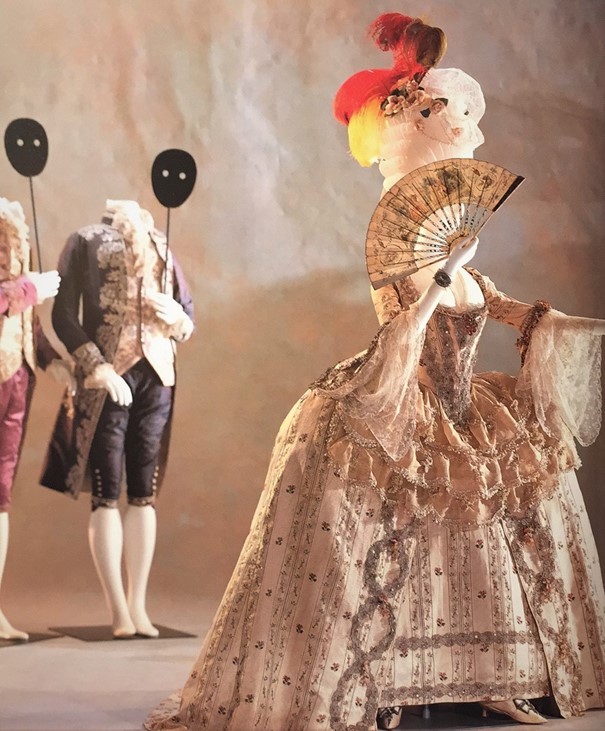
English C.1775
White striped floral Spitalfields silk cannele with metallic lace trim; double-layered pagoda sleeves; triple-layered engageantes in Brussels lace; silk gauze apron with fly fringe and chenille decoration.
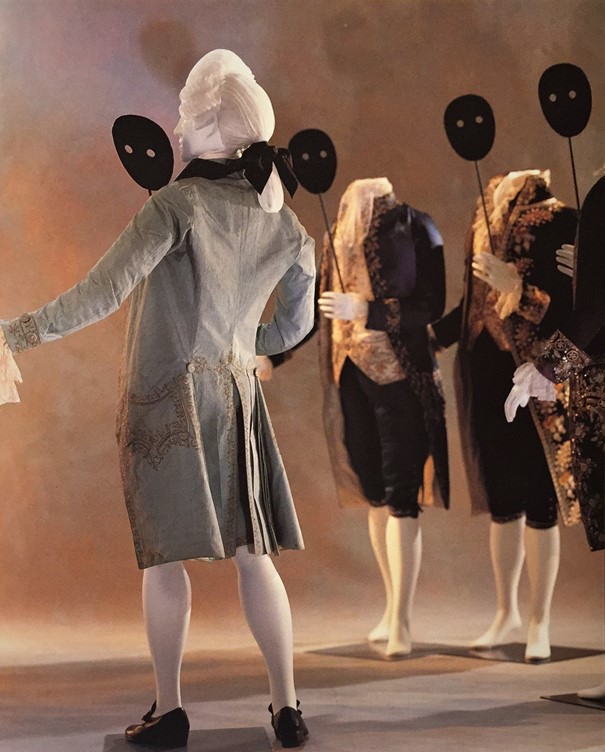
French 1770-1780s
Set of coat, waistcoat, and breeches of pale blue striped silk taffeta with woven floral trim; sleeve ruffles in needlepoint lace.
In the eighteenth century, the elegance of embroidery appeared in men’s fashion. In particular, the coat and the waistcoat were impressively embroidered with polychrome silk threads, gold and silver threads, sequins and artificial jewels. Many embroidery workshops were located in Paris at that time, and Diderot described such a workshop in his Encyclopedia. At the workshop, the customer would select the already embroidered fabric, and the fabric was then cut and sewn to fit. This method of tailoring was called a la disposition. Many decorative buttons adorned eighteenth century men’s suits. Skillfully crafted artistic buttons made of porcelain, embroidery, metalwork and glass were stylish elements of men’s fashion.
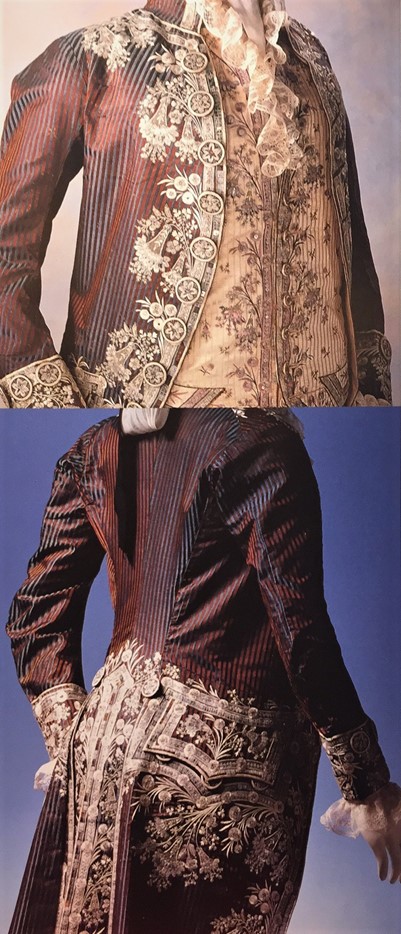
French C.1780
Three-piece set of coat, waistcoat, and breeches; coat and waistcoat of striped Lyons silk brocade, embroidered with sequins and mirror beads, waistcoat in silk cannele, self-fabric wrapped buttons.
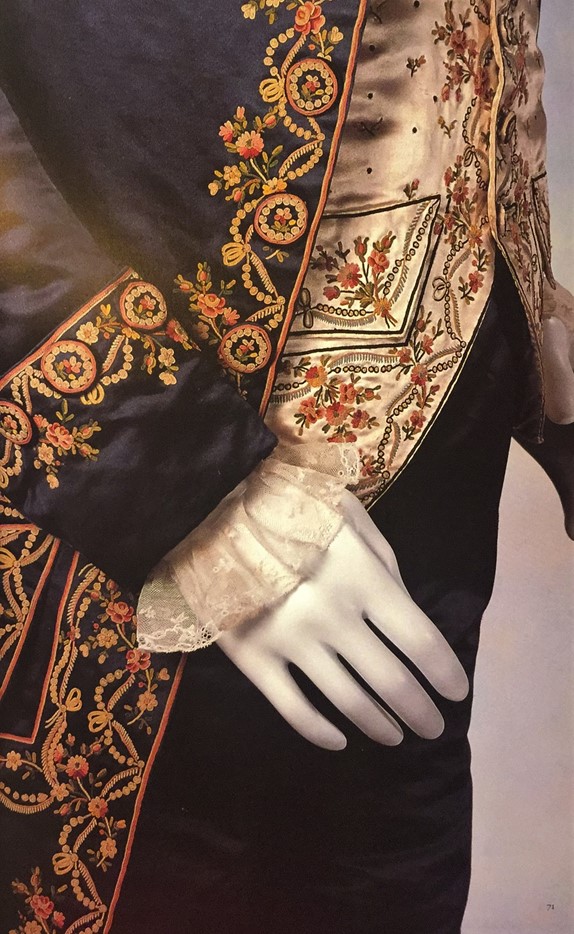
French C.1770
Three-piece set of coat, waistcoat, and breeches; coat and waistcoat of blue silk satin; waistcoat of white silk taffeta, Beauvais embroidery; self-fabric wrapped buttons.
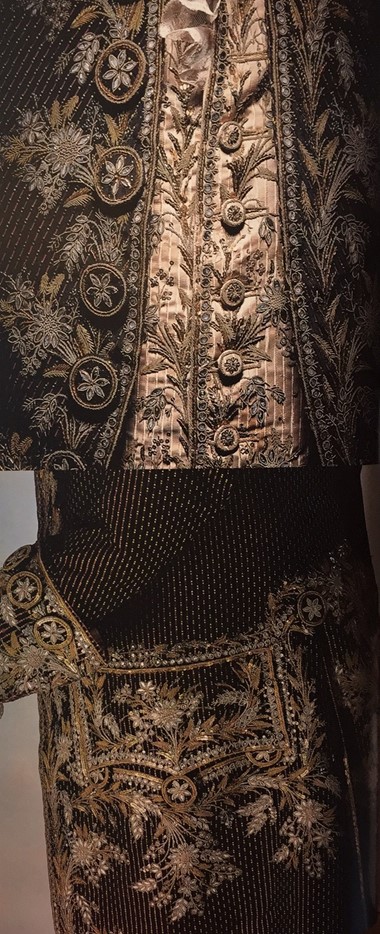
French C.1790
Three-pieces set of coat, breeches, and breeches; coat and waistcoat of blue striped uncut velvet with sequins and glass jewels; embroidery of metallic thread; self-fabric wrapped buttons; waist coat of white figured silk.
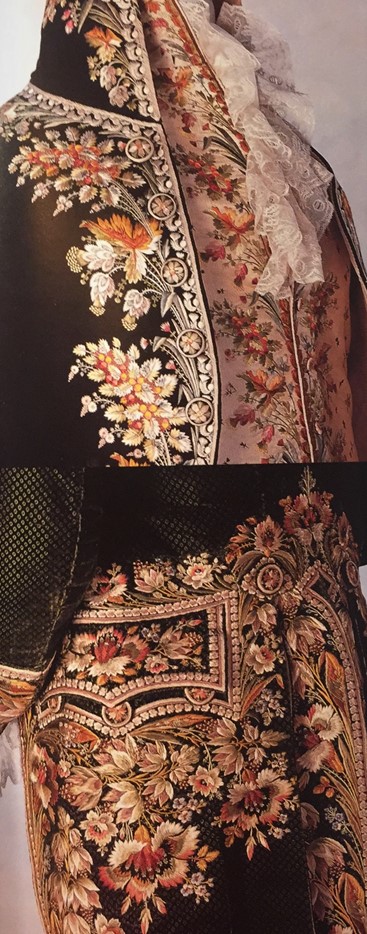
French C.1810
Three-pieces set of coat, waistcoat, and breeches; coat and breeches of black wool broadcloth with colored-thread embroidery; high standing collar; self-fabric wrapped buttons; waistcoat of white silk satin with polychrome embroidery.
Man’s Suit (habit a la française)
French C.1790
Coat and breeches of green cut velvet with polychrome floral silk embroidery; high standing collar; buttons wrapped with fabric.


